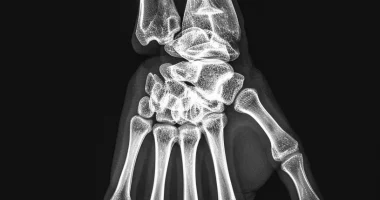Hip injury
General information
With age, the density of bone tissue decreases significantly. This is due to the body’s natural aging, in which regenerative abilities deteriorate, the amount of moisture in tissues decreases sharply, the activity of cellular processes slows down, and the hormonal background of the person changes. A natural consequence of these changes will always be an increased risk of fractures and other hip injuries.
Hip injuries are much less common in young people and are usually caused by traffic accidents, severe crashes, and falls from heights. In addition, the hip joint is subject to contusions, sprains, and strains of the periarticular tissues, just like any other joint.
What kinds of hip injuries are common?
Hip contusion.
It usually develops with moderate mechanical impact on the joint area. At the site of injury, there may be hematomas, soft tissue swelling, and localized soreness. In the case of severe contusion, there may be hemorrhage into the joint cavity, which requires puncture. Bone-traumatic changes in contusions are not present. A person with such a hip injury does not need hospitalization; treatment usually consists of dynamic observation and pain medication.
Stretching of the muscles and ligaments of the hip
This type of injury usually develops with a contusion or any other injury. Usually, such an injury is sustained by professional athletes in the process of power loads, but sometimes it occurs in everyday life. When stretching the muscles or ligaments of the thigh, a person is bothered by sharp pain, which is often localized at one point, and as a consequence, there is a limitation of the volume of movement in one of the planes. At the same time, axial load on the limb is possible, and its supporting function has not changed. Conservative treatment is aimed at pain relief and immobilization.
Hip dislocation
This injury occurs due to a sharp single mechanical stimulus, the force of which exceeds the functional capacity of the joint. In a dislocation, the relationship between the articular surfaces of the acetabulum and the femoral head is disturbed. Depending on the direction of the displaced head, dislocations are distinguished:
- posterior superior (iliac), which is the most common.
- posterior inferior (sciatic)
- anterior posterior (suprapubic)
- anterior inferior (obturator)
- central – in acetabular fractures, the head of the femur is submerged in the pelvic cavity.
Hip dislocation is an emergency requiring urgent intervention. Treatment involves repositioning the articular surfaces under general anesthesia with complete muscle relaxation. Central hip dislocation is treated with skeletal traction.
If the dislocation is not corrected in time, the body tries to compensate for the injury as much as possible by growing connective tissue around the joint and thickening the ligamentous apparatus. This allows minimal functionality and prevents the displaced bone from damaging the periarticular tissues and neurovascular bundles.
Treatment of a stale dislocation is surgical only.
Femur fractures
Depending on whether the skin is damaged, they come in:
- Open
- Closed
By the displacement of the fragments:
- Displaced
- Non-displaced
How do you know if there is a femur fracture?
There are several typical signs by which you can confidently identify such an injury:
- Severe pain syndrome
- Inability to actively move the leg
- Inability to lift your foot off the surface
- Symptom of external rotation
- Limb shortening
- Characteristic crunch (crepitation) of bone fragments when palpating the affected area
- The presence of a lesion on a radiograph
Fracture of the femoral neck
It is difficult to identify a hip joint injury that is more common. It is a classic injury characteristic of people in old age. Femoral neck fractures are more common in women; this is due to the onset of menopause and a decrease in estrogen levels, which are responsible, in particular, for bone density. The mechanism of injury is a typical fall from one’s height. At first glance, this unimportant cause is enough for an elderly person to acquire a severe obstacle in his ordinary life.
Types of femoral neck fractures by location:
- Subcapital – the line is just under the head of the femur bone
- Transcervical – the line crosses the cervix
- Basis cervical – the line is at the base of the cervix
Treatment of femoral neck fractures
Different tactics are used in different age categories of patients. However, the basis of the method of choice is the probability of bone fusion without intervention. The more a person has concomitant pathologies or is in a forced recumbent position, overweight, or has a history of cancer – the less likely it is that the fracture will heal on its own. Why does this happen? Due to anatomical features, this part of the bone is more vulnerable to such damage than any other. And since the neck is an area with a reduced blood supply, and in the case of trauma, vessels are additionally ruptured, and the tropism of the affected area can stop, the fusion sometimes does not occur at all. Early rehabilitation and moderate, dosed physical activity are the basis for the fusion of the femoral neck.
When independent fracture fusion is practically impossible, hip arthroplasty is successfully used.
A transtrochanteric fracture of the femur
In this type of injury, the fracture line passes through the greater and lesser trochanters in the proximal femur. This type isoften displaced and torn off the fibula.
First aid for a person with a hip fracture
Since the femur is the largest bone in the human body, has a large network of blood supply and innervation, and is part of the largest and most critical joint, timely and correct first aid for its fractures is necessary. This will help avoid unpleasant complications and significantly help in further treatment and rehabilitation.
Measures worth applying immediately at the scene of a hip injury:
- Injection of an anesthetic
- Examine the limb for bleeding and stop it
- Fixation of the injured limb with a Diterichs splint or a modified Kramer splint
After first aid, it is mandatory to transport the person to a specialized institution, where he will be thoroughly examined and given complete medical care.
All these treatment options are available in more than 840 hospitals worldwide (https://doctor.global/results/diseases/hip-injury). For example, Hip arthroscopy can be done in these countries for following approximate prices:
Turkey $4.1 K in 14 clinics
United States $12.6 K in 15 clinics
Germany $12.9 K in 35 clinics
China $16.5 K in 6 clinics
Israel $20.7 K – 29.4 K in 13 clinics.

